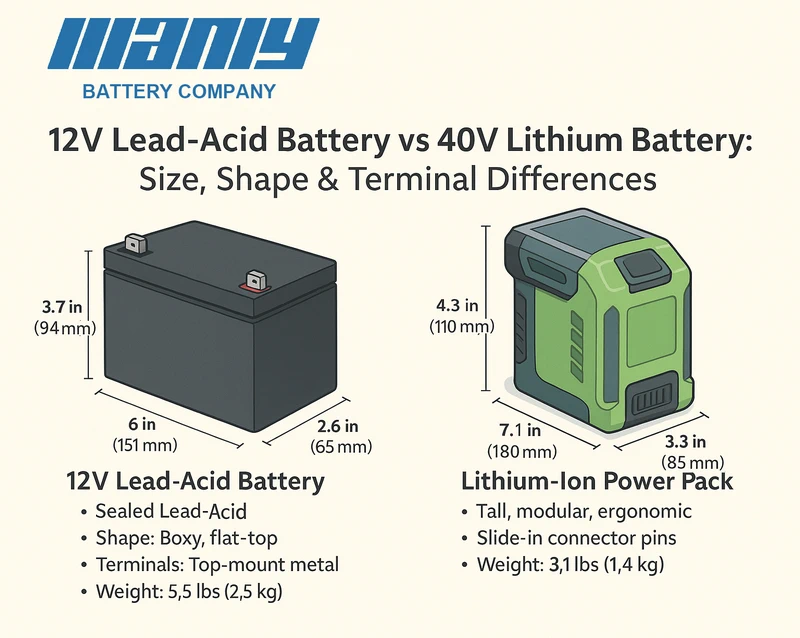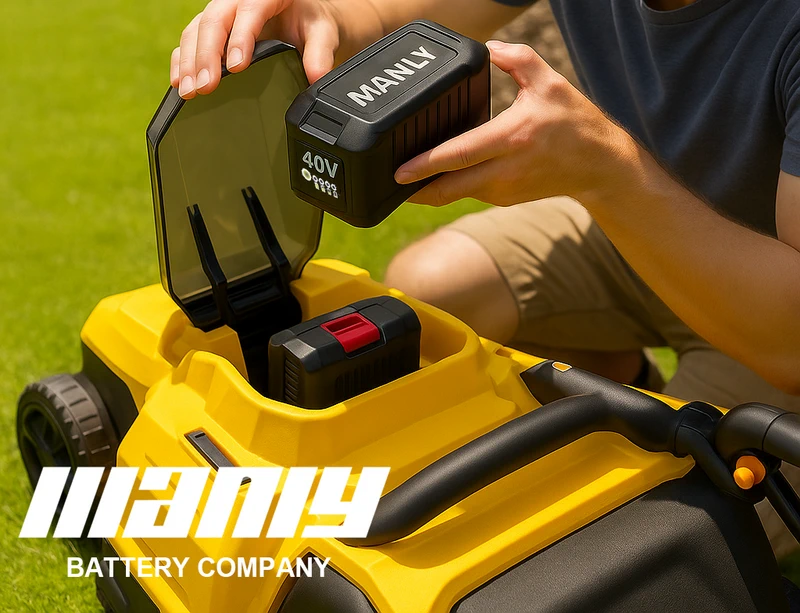What Voltage Is Lawn Mower Battery
Table of Contents
- What Voltage Is Lawn Mower Battery
- Common Lawn Mower Battery Voltages Explained
- How Battery Voltage Affects Lawn Mower Performance
- How to Check Lawn Mower Battery Voltage
- Matching Battery Voltage to Lawn Size and Usage
- Battery Care Tips to Maximize Performance
- Lithium Battery Replacement Solutions for Popular Lawn Mower Brands
- Conclusion
- FAQ
- Hot Search
- Learn More About Battery
Understanding lawn mower battery voltage is essential for making wise, long-lasting choices—especially as cordless models powered by lithium technology continue to replace gas mowers across American homes. From the widely used 40V battery systems in residential tools to more powerful options for large properties, voltage plays a direct role in runtime, cutting strength, and charging needs. Whether using a walk-behind electric mower or a riding model, choosing the correct battery isn’t just about fit—it’s about performance, longevity, and cost-efficiency. This guide includes everything you need to know about cordless lawn mower battery voltages, testing methods, care tips, and why many resellers are turning to trusted battery manufacturer solutions for high-quality replacements.
Common Lawn Mower Battery Voltages Explained
1. Gas Mowers: Why Most Use 12V
Gas-powered lawn mowers typically rely on a 12-volt lawn mower battery to start the engine and power onboard electronics like headlights or control panels. This has become an industry standard because 12V lead-acid batteries offer a reliable balance of output, affordability, and compatibility across both push and riding mower models. Some older or compact models may use 6V batteries, but these are increasingly rare.
When fully charged, a healthy 12V battery generally reads between 12.6 and 12.8 volts. If it drops below 12.2 volts, it may fail to start the mower consistently. Regular testing and charging are critical for seasonal users to avoid voltage dips during storage.
2. Cordless Mowers: 20V to 80V Options Compared
Cordless electric lawn mowers have expanded battery voltage options over the last decade, mainly due to advancements in lithium-ion technology. Today, you’ll find cordless lawn mower battery systems that range from 20V up to 80V, depending on the size of the mower and the demands of the lawn it’s designed to maintain.
- 20V: This voltage is ideal for lightweight mowers used on small, flat lawns. These mowers offer limited runtime and torque but are budget-friendly.
- 40V battery: A go-to for mid-sized lawns. They balance runtime, power, and ease of handling. Most residential cordless mowers in the U.S. fall into this category.
- 60V and 80V: Built for larger or more demanding yards. These high-voltage systems offer increased torque and runtime, often matching the performance of smaller gas-powered models. They’re also favoured by users needing to cut thicker grass or work on uneven terrain.
While voltage alone doesn’t tell the full performance story (amp-hours and motor efficiency matter, too), it’s a critical metric when choosing a mower for your specific yard conditions.

3. Where 40V Batteries Fit In for Residential Use
The 40V battery has become one of the most popular choices for American homeowners. It provides enough power to handle 1/4 to 1/2-acre yards with typical grass density. It’s also widely supported by major cordless mower brands and is compatible with various tools on shared battery platforms. For most users, a 40V setup delivers the sweet spot of runtime, cost, and weight.
Unlike high-end commercial systems that may push 80V, the 40V setup is lightweight, easy to charge, and meets EPA and noise-reduction preferences—especially in suburban neighbourhoods.
How Battery Voltage Affects Lawn Mower Performance
1. Power and Runtime Considerations
In a cordless lawn mower battery, voltage determines how long the mower can run on a single charge and how much power it can deliver while cutting. Higher voltage generally allows the mower to draw more watts, powering the blades at higher speeds or for longer sessions.
For example, a 40V system with a 5Ah capacity will give you roughly 200 watt-hours (Wh) of energy. Depending on conditions, that’s usually enough for 30 to 45 minutes of mowing. Upgrade to a 60V system, and you extend that capability substantially.
2. Handling Thick Grass and Uneven Terrain
Grass type and terrain matter. Thicker, wet, or fast-growing grass puts more strain on the motor. That’s where higher voltage shines. A 60V or 80V cordless lawn mower battery provides greater torque and cutting strength, preventing blade stalling and ensuring smoother, even cuts—even through dense patches.
For homeowners with hills, uneven plots, or dense grass varieties like Bermuda or Fescue, opting for a higher-voltage mower is not just a luxury—it’s a necessity.
3. Efficiency and Operating Noise Levels
Battery voltage also affects motor efficiency. Higher voltage systems tend to run at optimal RPMs with less energy loss, resulting in better performance and longer battery life. They also generate less heat, which helps extend the battery’s overall health and reduces maintenance costs.
Another underrated benefit is quieter operation. Higher-voltage motors run more smoothly and efficiently, reducing mechanical noise. This matters for residential users who want to mow early in the morning or in noise-sensitive communities.
How to Check Lawn Mower Battery Voltage
1. Tools You’ll Need (Multimeter, Gloves, etc.)
To accurately check your lawn mower battery voltage, you need a few basic tools: a digital multimeter, safety gloves, and a clean cloth. The multimeter should be set to DC voltage mode. Gloves protect your hands from battery acid or corrosion, especially with lead-acid models. Before testing, ensure the mower is turned off, and the battery has rested for at least 30 minutes to stabilize the charge.
2. Step-by-Step Voltage Testing Process
- Turn off the mower completely and remove the ignition key.
- You can access the battery, which is usually under the seat (for riding mowers) or near the handle (for walk-behind models).
- Inspect the terminals for dirt, corrosion, or loose cables. If necessary, clean them with a brush or cloth.
- Set your multimeter to DC volts (at least 20V range).
- Place the red probe on the positive terminal (+) and the black probe on the negative terminal (-).
- Read the voltage on the display. A healthy reading for 12V lead-acid batteries should be between 12.6V and 12.8V. For lithium-ion batteries, check the manual for expected full-charge values.
3. What the Readings Mean and When to Recharge
- 12.6V – 12.8V: Fully charged and ready to go.
- 12.2V – 12.5V: Partially charged; recharge soon.
- Below 12V: Low charge; recharge immediately.
- Below 11.5V: The battery may be damaged or sulfated. Consider replacing.
Recharge the battery with a compatible charger. Avoid overcharging and monitor voltage during storage months to prevent deep discharge.

Matching Battery Voltage to Lawn Size and Usage
1. Small Lawns: 20V–40V Is Enough
A cordless lawn mower battery in the 20V to 40V battery range is ideal for homeowners with small, flat yards. These mowers offer lightweight handling and enough runtime to cover up to a quarter acre. A 40V battery strikes the right balance for basic tasks and is widely available from most battery manufacturer offerings.
2. Medium Yards: 40V–60V for Balance
If your lawn is between a quarter and half an acre or includes modest slopes, step up to a 60V system. While many users stick with a 40V battery, upgrading to a 60V model gives you more torque and runtime without a huge jump in weight. These mowers also support interchangeable batteries across other yard tools, which adds convenience.
3. Large Lawns and Heavy Use: 80V and Beyond
For properties over half an acre or with thick, wet grass, 80V or even 120V systems deliver the power needed. High-voltage cordless lawn mower battery setups provide extended runtimes and higher torque, which is especially useful for commercial users or homeowners who mow less frequently. These models are heavier and costlier but designed for performance over long sessions.
Battery Care Tips to Maximize Performance
Keeping your lawn mower battery in peak condition isn’t just about charging it occasionally—it’s about following smart care habits that extend its life and performance. Whether you’re using a 40V battery, a traditional 12V lead-acid battery, or a newer lithium-ion model, the right practices make all the difference.
1. Charging Best Practices by Battery Type
Not all lawn mower batteries charge the same way. Here’s how to do it right, based on your battery type:
- Lead-Acid (Flooded): These are common in gas mowers with electric starts. Always use a 12V charger designed for lead-acid batteries. Don’t let the charge drop below 12.4V, and check fluid levels regularly—use only distilled water to top up.
- AGM Batteries: These sealed lead-acid batteries are low maintenance but need regular charging. Use a smart charger that prevents overcharging and keeps the terminals clean and dry.
- Lithium-ion batteries are found in many cordless lawn mower battery systems, especially those using a 40v battery. Always use the charger that comes with your battery, and never leave it plugged in for days. Charge before storage and again before the first mow in spring.
Regardless of type, avoid full discharge cycles. When stored long-term, keeping the battery between 40% and 80% can improve its lifespan.
2. Storage Advice for Winter and Off-Season
Cold weather can damage a battery if it’s not stored correctly. Here’s what to do:
- Remove the Battery: Never leave your lawn mower battery inside the mower during freezing temperatures. Take it out and store it indoors, ideally between 50–70°F (10–21°C).
- Clean Before Storage: Wipe down the battery and terminals to prevent corrosion buildup. If necessary, use a mix of water and baking soda.
- Charge Before Storing: Lead-acid batteries should be stored entirely and topped up every 30 days. Lithium-ion batteries can be stored at 50% charge but still benefit from a refresh every 3–6 months.
- Use a Trickle Charger: For long-term storage, especially lead-acid types, connect a smart trickle charger to maintain optimal voltage without overcharging.
3. Cleaning and Maintenance Guidelines
Dirt and corrosion reduce performance and can shorten your battery’s life. Here’s how to maintain it:
- Inspect Terminals: At least once a month during mowing season, check the terminals for rust or white residue. Corrosion interferes with charging and discharge.
- Clean the Contacts: If buildup appears, disconnect the battery (starting with the negative terminal) and scrub with a stiff brush dipped in a baking soda solution. Dry completely before reconnecting.
- Check for Damage: Swollen casing, leaks, or cracked terminals mean replacing the battery is time. Always buy from a trusted battery manufacturer to ensure safety and reliability.
- Secure Placement: Loose batteries can vibrate and wear prematurely. Ensure the battery is firmly seated in its tray and secured with the hold-down bracket.
Lithium Battery Replacement Solutions for Popular Lawn Mower Brands
1. Meeting the Demand for 40V Battery Replacements Across Major Brands
The need for reliable lithium battery replacement options has surged as cordless mowers continue to replace gas-powered models. Many of today’s electric mowers, primarily from leading brands like Ryobi, Greenworks, Kobalt, and HART, rely on the 40v battery platform. These batteries balance performance and weight, making them ideal for residential mowing.
However, battery wear is inevitable. Over time, original equipment manufacturer (OEM) batteries lose capacity or become discontinued, leaving users with limited options. That’s where third-party cordless lawn mower battery suppliers step in. Quality replacement solutions help users extend the life of their mowers without switching to an entirely new system.
For example, many Greenworks and Ryobi models run exclusively on 40V platforms, and compatible lithium replacements ensure homeowners don’t need to repurchase tools or chargers. These replacements match OEM form factors and voltage profiles, supporting the same runtime and performance. Some even outperform OEM batteries with higher amp-hour ratings or improved heat management features.
Aftermarket solutions from trusted battery manufacturer networks have grown to meet this demand. These providers often supply custom lithium battery packs that match or exceed original performance. The goal is to allow lawn care professionals and everyday users to keep their gear working without overpaying for brand-name accessories.
When shopping for a 40v battery replacement, U.S. customers prioritize safety certifications (such as UN38.3 or UL), consistent runtime, and compatibility with stock chargers. Reputable manufacturers often provide built-in battery management systems (BMS) to prevent overcharging or deep discharge. The result is a smoother mowing experience and fewer interruptions in peak season.
2. Why U.S. Resellers and Distributors Prefer Custom Lithium Battery Manufacturers
Many American resellers and online retailers serve the growing demand for aftermarket lithium battery replacement solutions in today’s market. Instead of relying solely on big-name brands, these businesses increasingly partner with flexible battery manufacturer operations capable of delivering custom packs at scale.
Custom lithium battery makers offer significant advantages. First, they provide consistent supply chains and tailored designs that match popular mowers’ exact casing, terminal type, and voltage requirements. This is crucial for retailers selling replacement packs for discontinued or niche models.
Second, custom cordless lawn mower battery suppliers offer better pricing and margin control. For instance, bulk orders for private-label 40V batteries allow sellers to compete with OEM pricing while delivering equivalent or superior performance.
Third, custom manufacturers enable design flexibility. If a seller wants to offer extended-runtime batteries (say, 6Ah instead of 2Ah) for Ryobi or HART platforms, they can partner with a manufacturer who tailors the cell configuration and BMS accordingly.
Most importantly, partnering with a trusted battery manufacturer ensures long-term support and technical documentation—essential for regulatory compliance and customer confidence. As the U.S. cordless mower market grows, resellers with high-quality replacements build stronger reputations and attract loyal repeat buyers.
Conclusion
Choosing the correct lawn mower battery and keeping it in top shape can make all the difference in how smoothly your mowing season goes. Whether running a 40V battery on a compact residential model or managing larger tools with high-capacity packs, voltage isn’t just a number—it determines power, performance, and value over time. As more users move toward electric options, having access to reliable cordless lawn mower battery replacements matters more than ever. That’s why partnering with a proven battery manufacturer for long-lasting, compatible lithium replacements helps ensure you get the most from your equipment—season after season.
FAQ
1. How long does a 40V lawn mower battery last?
A fully charged 40V lawn mower battery typically lasts 30 and 45 minutes, depending on grass thickness, terrain, and mower efficiency. For small to medium-sized lawns (up to ½ acre), this is usually enough to complete a full mow in one session. Battery age, capacity (Ah rating), and temperature also affect runtime. If you notice a drop in performance, it may be time to recharge or replace the battery.
2. Is an 80V mower more potent than a 40V mower?
An 80V mower generally delivers more power and torque than a 40V battery model. The higher voltage allows it to cut through thicker, wetter grass and handle larger yards more efficiently. It also provides longer runtime and higher blade speed. However, a 40V cordless lawn mower battery may still be the more convenient and cost-effective choice for smaller, flat lawns.





